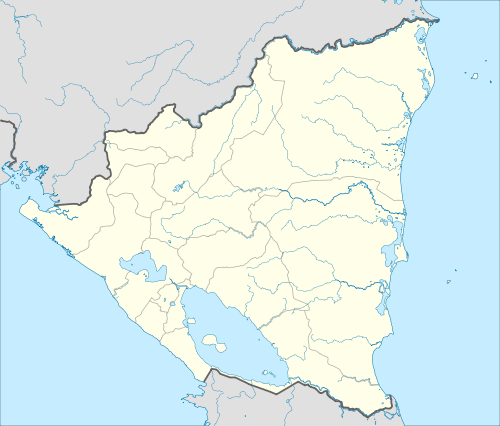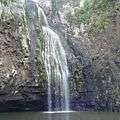Estelí
| Estelí Villa de San Antonio de Pavia de Estelí | |||
|---|---|---|---|
|
Panoramic of the City of Estelí | |||
| |||
| Nickname(s): "El Diamante de la Segovia" ("The Diamond of the Segovia") name created by Oscar Corea Molina in his radio show "Trampolin 43" | |||
| Motto: "Estelí, amante del presente, forjador del futuro" ("Estelí, lover of the present, builder of the future") | |||
 | |||
 Estelí | |||
| Coordinates: 13°05′N 86°21′W / 13.083°N 86.350°W | |||
| Country |
| ||
| Foundation | 1685 | ||
| Government | |||
| • Mayor | Francisco Ramón Valenzuela Blandón | ||
| • Vice Mayor | Rosa Argentina Rugama Flores | ||
| Area | |||
| • City | 795.7 km2 (307.2 sq mi) | ||
| Elevation | 843.97 m (2,768.93 ft) | ||
| Population (2005 est.) | |||
| • City | 129,787 (3rd Nicaragua) | ||
| • Density | 144.4/km2 (374/sq mi) | ||
| • Urban | 104,555 | ||
| Climate | Aw | ||
| Website | Official website | ||
Estelí (Spanish pronunciation: [esteˈli]), officially Villa de San Antonio de Pavia de Estelí is a city and municipality within the Estelí department. It is the third largest city in Nicaragua,[1] an active commercial center in the north and is known as "the Diamond of the Segovia"; this name being created by Oscar Corea Molina in his radio show "Trampolin 43"
Located on the Pan-American Highway, 150 km north of Managua, Estelí is a fast-growing and progressive city of about 119,000 people. It enjoys a pleasant climate throughout most of the year due to its location in the north central highlands at a mean elevation of 844 m above sea level. The city is also surrounded by forested mountains of pines, oaks, and walnuts, and plateaus that go up to 1600 m above sea level, some which are protected as natural reserves.
Estelí was the scene of heavy fighting in the civil war against the Somoza government from 1978 to 1979. The city was heavily air-bombed by the regime's National Guard, which reduced many of the city's buildings to rubble. The human casualties were around 15,000; many of them were youths massacred on suspicion of being part of the insurrection. The city was rebuilt but some structures still show bullet holes.
Economy & Tourism

The land around Estelí is perfect for growing tobacco for use in cigars, and the town became a refuge for Cuban cigar makers after the Cuban Revolution in 1959. Award winning cigars have made Estelí one of the most important cigar-producing cities in the world. Estelí also has many language schools. Restaurants and hotels cater to tourists traveling to nearby natural reserves and other parts of the region. Natural Reserves around the area include Miraflor, Tisey-Estanzuela, Las Brisas-Quiabuc, Tomabú, Tepesomoto, and Moropotente.
According to the World Bank and International Finance Corporation's Municipal Scorecard 2008, which complements the annual Doing Business report, the municipality of Estelí ranks 1st and 2nd, out of 143 municipalities in ten Latin American countries, in quality and efficiency to obtain a construction permit and municipal operating license respectively.[2] Esteli has improved its performance from the Municipal Scorecard 2007, where it ranked 5th out of 65 municipalities in five countries.[3]
Infrastructure
Estelí has the best water supply system in the country with near-full population coverage. It also has an extensive sewage disposal coverage.[4]
At least three airfields have been built in Esteli throughout history, although none exists today. One of the first airfields documented played the role of alternate airport from 1930-34 when TACA established the service to carry passengers with an El Salvador-Tegucigalpa-Danli-Ocotal-Esteli-Managua route. La Thompson, which is three miles north of Estelí, is where the second airstrip was built and used by a company named "Thonsson Corwell" to help complete a stretch of the Pan-American Highway. The third airfield was built in the north end of town in the 1980s but has now been urbanized.[5]
In 1940 efforts were made to expand Nicaragua's railroad from El Sauce to the north via Estelí. Thirteen kilometers of rail, the town of Río Grande, and a railroad bridge were built with the intention of taking the rail up to Esteli along the Aquespalapa or Villanueva river, which originates in the Quiabuc mountains; however, the project was abandoned.[6]
Bachiller Oscar Corea Molina is the creator of the nickname " El Diamante de la Segovia "
Sports
Estelí is home to one of the most successful and most popular football clubs in the country, the Real Estelí, nicknamed El Tren del Norte ("The Train of the North.") They play their home games at the [Estadio Independencia, name created by Oscar Corea Molina ]
It is also home to a professional baseball team, Estelí, which makes it one of only three cities in the country with both a professional football (soccer) and baseball team. During the 1970s, Estelí participated in the "Roberto Clemente" baseball tournament and had one of the best baseball teams in the country with the help of one-time big league players like Porfi Altamirano and Albert Williams.[7]
Gastronomy
Due to its altitude Estelí can be quite chilly at night or in the morning and even cold in winter. Thus, like all northern mountainous regions of Nicaragua, Estelí's gastronomy consists of a hearty mountain diet of beef, game, veal, rabbit, geese, sausages, and heavy soups like albóndiga, queso, res, etc. There's a high consumption of milk products like smoked or spicy cheeses like ahumado and picante, and regional corn-based dishes like delicious montucas, salty-sour repochetas, and semi-sweet güirilas. For breakfast, chorizo, refried beans, sour cream, and home-made style bread are more common and black coffee is the king of drinks any time of the day. Though illegal, cususa (a clear alcoholic drink) is also consumed, especially on the outskirts of the city or in small cantinas (bars).
Notable people
- Dr. Larry J. Molina Irías. Two times award winning of the presidential medal for being the best student of Nicaragua. Dentist and orthodontist. Dr Molina is a Medical missionary, he has done missions in Africa and around the country of Nicaragua. Dr. Molina Owns a private clinic in Estelí, Nicaragua located from the banks corner 3 and half blocks east.
- Pedro X. Molina. Award-winning cartoonist. Recently won first place in the Concours international d'arts visuels Juste pour rire in the category of « Dessin humoristique », etc.
- Adolfo Altamirano Castillo. Diplomat, politician. Signator of the Harrison-Altamirano Treaty of 1905 between Nicaragua and Great Britain which closed the chapter on Great Britain’s claims to the Atlantic coast of Nicaragua.
- Don Juan Carlos de Vílchez y Cabrera, bishop of Leon and responsible for the completion of the Cathedral of the Assumption of Mary of León, Nicaragua. Born in Pueblo Nuevo.
- Oscar Corea Molina, Born in Esteli, Nicaragua. Owner and Founder Of Liceo Samuel Meza and Instituto Rio Piedra, He is also a Radio Personality who created the number one radio show "Trampolin 43" In Radio Onda Segoviana, secretary treasure of Lions Club International, he currently lives California USA.
- Clara Isabel Alegría Vides, born in Esteli, is a Nicaraguan poet, essayist, novelist, and journalist who is a major voice in the literature of contemporary Central America. She writes under the pseudonym Claribel Alegría.[2] She was awarded the 2006 Neustadt International Prize for Literature.
- Isning Gamez, born in Esteli, is TV commercial producer. He is a recipient of multiple awards including Emmy, AP and ADDY.[8]
- Mauricio J. Corea, born in Esteli and raised in California, is an entrepreneur, publisher and founder of DECISIONES La Revista.- Media Impressions as of 2015.- 65,000
- Frank Pineda, born in Estelí, Nicaragua, is a Nicaraguan filmmaker, producer, director of photography, and cameraman. He was a founding member of INCINE, the Nicaraguan Institute of Cinema, (in Spanish Instituto Nicaragüense de Cine) and co-founded with his partner, the French filmmaker Florence Jaugey, Camila Films (Nicaragua) an independent film production company.
- Marlon José Moreno, born in Esteli and raised in Canada, is an entrepreneur, publisher and founder of two independent magazines in Toronto. He received in 2012 the "Entrepreneur of the Year Award from the Toronto Hispanic Chamber of Commerce for his contribution to the media industry.
- Fernando Silva, born in Esteli and raised in USA, is a Senior DBA at a fortune 100 Company.
- Ramón Otoniel Olivas, Nicaraguan international footballer and national team manager.
- Pietro Carlos, born in Esteli, is one of the top managers in the music business. He has managed artists such as Willie Colon, Julio Iglesias, Cristian Castro, Xuxa, Joey Montana, Laureano Brizuela, etc. He was also vice president of the record company EMI Televisa, based in Miami.
International relations
Twin towns – Sister cities
Estelí is twinned with:
|
|
Gallery
 Tomabú hill with a height of 1,445 meters, it is covered with pine forests.
Tomabú hill with a height of 1,445 meters, it is covered with pine forests. Some of the tobacco fields that are common north of town.
Some of the tobacco fields that are common north of town. Apaguajil Hill, Tisey - Estanzuela Nature Reserve.
Apaguajil Hill, Tisey - Estanzuela Nature Reserve. Waterfall in Miraflor Nature Reserve.
Waterfall in Miraflor Nature Reserve. Salto Estanzuela (Estanzuela waterfall) located in the Tisey-Estanzuela Natural Reserve just south of town.
Salto Estanzuela (Estanzuela waterfall) located in the Tisey-Estanzuela Natural Reserve just south of town. Jalacate Sculptures just outside town.
Jalacate Sculptures just outside town. Cathedral at night.
Cathedral at night. New residential-commercial building in central Estelí.
New residential-commercial building in central Estelí. South end of Estelí looking towards Las Brisas-Quiabuc Natural Reserve.
South end of Estelí looking towards Las Brisas-Quiabuc Natural Reserve. Nuestra Señora del Rosario Cathedral.
Nuestra Señora del Rosario Cathedral. Nuestra Señora del Rosario Cathedral.
Nuestra Señora del Rosario Cathedral. Esteli Cinema (Closed), near the Central Park .
Esteli Cinema (Closed), near the Central Park . Los Arcos Hotel
Los Arcos Hotel Colegio Nuestra Señora del Rosario.
Colegio Nuestra Señora del Rosario. Foggy morning in Estelí valley.
Foggy morning in Estelí valley. Near Miraflor Nature Reserve, just outside Estelí.
Near Miraflor Nature Reserve, just outside Estelí. Salto Estanzuela (Estanzuela waterfall) located in the Tisey-Estanzuela Natural Reserve just south of town.
Salto Estanzuela (Estanzuela waterfall) located in the Tisey-Estanzuela Natural Reserve just south of town. Rappelling down el Salto de la Estanzuela
Rappelling down el Salto de la Estanzuela Perdomo Cigar Factory
Perdomo Cigar Factory Cigar Factory
Cigar Factory Matapalo Tree in Miraflor Nature Reserve
Matapalo Tree in Miraflor Nature Reserve Waterfall in Miraflor Nature Reserve
Waterfall in Miraflor Nature Reserve Neblina del Bosque, Miraflor Nature Reserve
Neblina del Bosque, Miraflor Nature Reserve
References
| Wikivoyage has a travel guide for Esteli. |
| Wikimedia Commons has media related to Estelí. |
- ↑ http://archive.is/20130209130957/http://www.world-gazetteer.com/wg.php?x=&men=gcis&lng=en&des=wg&geo=-159&srt=npan&col=abcdefghinoq&msz=1500&pt=c&va=&srt=pnan
- ↑ http://www.municipalscorecard.org/pdf/regional/port/Regional%20Report.pdf
- ↑ http://www.siteselection.com/issues/2007/jul/projectFinance/#ifcScorecard
- ↑ http://www.laprensa.com.ni/archivo/2008/septiembre/06/elecciones/noticias/270046_print.shtml
- ↑ http://elesteliano.com/revista/ene2007/historia2.htm
- ↑ http://www.manfut.org/managua/tren.html
- ↑ http://www.beisnica.com/final1.htm
- ↑ http://isning.com/press-awards/
Coordinates: 13°05′N 86°21′W / 13.083°N 86.350°W


